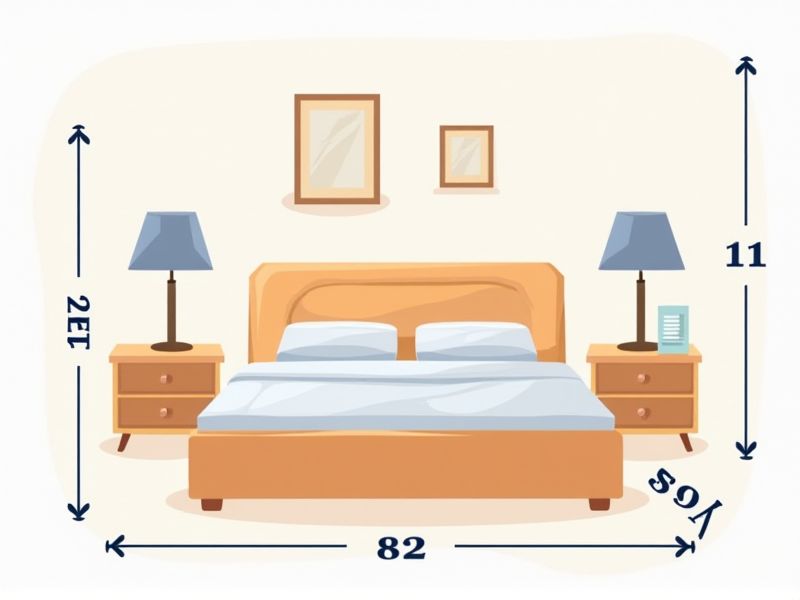
When planning a hotel or guesthouse, understanding standard guest room dimensions can help ensure comfort and functionality for your visitors. Typically, a standard single guest room measures around 12 feet by 15 feet (approximately 3.6 meters by 4.5 meters), offering enough space for a bed, a small work area, and storage. If you're designing a double room, increasing the size to about 12 feet by 18 feet (3.6 meters by 5.5 meters) can accommodate two beds and extra seating comfortably. Keeping these dimensions in mind can create a pleasant stay for guests while optimizing space usage and furniture placement.
Room Size
A standard guest room typically spans 300 to 400 square feet, accommodating essential furnishings like a queen or king-size bed, a dresser, and a desk. The layout often prioritizes user-friendly design, ensuring ample space for movement and comfort. Key amenities like a flat-screen TV, high-speed Wi-Fi, and an ensuite bathroom are standard features, enhancing your overall stay experience. With optimal lighting and soundproofing, a well-designed room aims to provide both relaxation and productivity for guests.
Ceiling Height
Ceiling height in guest rooms significantly influences the overall ambiance and comfort. Hotels typically aim for a minimum ceiling height of 8 feet, as this standard enhances spaciousness and airflow, ultimately boosting guest satisfaction. Higher ceilings, around 10 to 12 feet, can create a luxurious atmosphere, making rooms feel more expansive and inviting. When choosing a guest room, consider the ceiling height, as it can greatly impact your comfort and experience during your stay.
Window Dimensions
The standard window dimensions in guest rooms typically range from 24 to 36 inches in width and 48 to 60 inches in height, allowing for ample natural light and ventilation. These dimensions not only enhance the overall aesthetic but also improve energy efficiency by harnessing sunlight for passive heating. In urban settings, larger windows, sometimes exceeding 48 inches wide, can offer breathtaking views, significantly enhancing guest experience. Ensuring proper insulation around these window frames can contribute to a comfortable climate inside the room, reducing energy costs and increasing guest satisfaction.
Door Width
The standard door width for guest rooms typically measures 32 inches, ensuring accessibility and ease of movement for all guests, including those with mobility aids. This width accommodates the passage of wheelchairs and large luggage, enhancing the overall guest experience. Building codes often require this dimension to meet safety regulations and provide a welcoming environment. When planning your guest room, considering a wider door can elevate comfort and accessibility.
Bed Size
A standard guest room typically features a Queen-size bed, measuring 60 inches by 80 inches, providing ample space for couples or single travelers seeking comfort. However, many hotels offer King-size beds, which are 76 inches wide and 80 inches long, ideal for those who prioritize spaciousness during their stay. The bed quality is also crucial, often including premium mattresses that enhance sleep quality and overall guest satisfaction. Your choice of bed size can significantly impact the quality of your experience, making it essential to consider when booking accommodations.
Bathroom Facilities
In a luxury guest room, the bathroom typically features high-end amenities such as a rainfall showerhead and a whirlpool bathtub, providing a spa-like experience. Expect plush towels and premium toiletries, often sourced from renowned brands, elevating your personal care routine. Many upscale hotels equip their bathrooms with underfloor heating and ambient lighting, enhancing comfort and relaxation. Additionally, the inclusion of features like double sinks and separate water closets is common, ensuring convenience for multiple guests.
Closet Space
A standard guest room typically includes at least 5 to 10 linear feet of closet space, providing ample room for personal belongings. Many hotels also incorporate storage solutions such as shelves and hangers to optimize this area. Ensuring a well-organized closet enhances your experience, allowing easy access to luggage and clothing. Consider rooms that feature integrated lighting in the closet for added convenience and visibility.
Furniture Arrangement
An effective furniture arrangement in guest rooms enhances both function and aesthetics, optimizing space while ensuring comfort. Typically, a layout includes a king or queen-size bed positioned to facilitate easy movement, complemented by bedside tables to hold essentials. Incorporating a well-placed desk or seating area, ideally near a window, can provide a workspace for guests, promoting productivity. Consideration of at least 30 inches of walkable space around furniture pieces is crucial for a smooth flow and accessibility throughout the room.
Hallway Width
The standard width for hotel hallways typically ranges from 44 to 48 inches to ensure easy navigation and safety for guests and staff. Adequate hallway width promotes accessibility, essential for individuals using mobility aids, such as wheelchairs or walkers. In hotels, having wider hallways reduces congestion, particularly during peak check-in and check-out times, providing a more pleasant experience for you and other guests. Proper design also facilitates efficient housekeeping operations, contributing to overall guest satisfaction and positive reviews.
Emergency Exits
Emergency exits in guest rooms play a pivotal role in ensuring safety and compliance with regulations. Each guest room should ideally feature at least two accessible emergency exits, clearly marked and unobstructed, to facilitate quick evacuation. You should also ensure that exit routes are well-lit and equipped with illuminated signs to guide occupants during emergencies. Regular drills and clear communication about exit strategies can enhance guest preparedness, reducing potential risks significantly.
